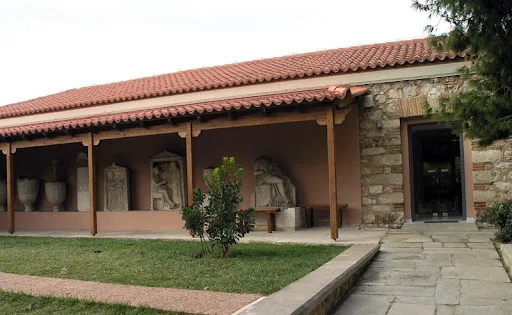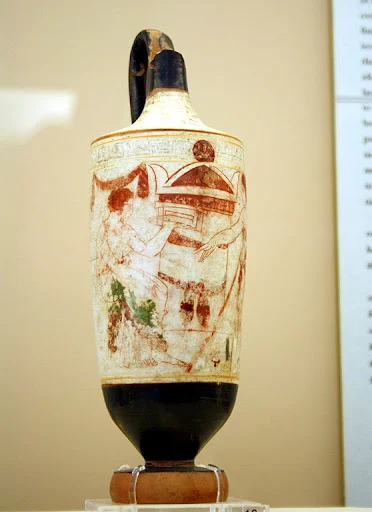Kerameikos Museum
Kerameikos Museum, is housed directly in the area of Ceramicus (today's Kerameikos) -among the famous archaeological site of the Kerameikos necropolis. In 1863, archaeologists first started housing pottery and other artifacts found during the excavations of the site in a small, makeshift outpost. It was an exhibit for the larger German Archaeological Institute until the official Museum was built.
Kerameikos Archaeological Site
The Kerameikos Museum is located to the left entrance of the archaeological site and was built in 1937 by H. Johannes, thanks to a donation from German industrialist Gustav Oberlander. The Boehringer brothers funded the expansion of the museum in the sixties.
It is a small, open-air museum with only four rooms on a single floor, but it houses the finds from the excavations carried out after its construction (many important funerary works as well as larger sculptures). The first finds of the excavations of the Kerameikos necropolis by the German Archaeological Institute were transferred to the National Archaeological Museum, where they are still kept. Inside of the museum there is a garden area with olive trees and laurels.
The exhibits of Kaerameikos Museum enable visitors to trance not only the evolution of an entire branch of ancient Greek art, namely funerary monuments, but also development of ancient Attic pottery from the 11th century BC until the first centuries after the birth of Christ and the Roman conquest. Due to the lack of written evidence about life in Athens during its early years, these two categories of finds constitute unique witnesses to the cultural activities of its nhabitants.
The chronological display of finds starts in the numbered cases to the right of the entrance in room II of the museum. Visitors can reach it directly from the main entrance, by passing Room I with the funerary monuments.
Grave relief of Dexileos, son of Lysanias, of Thorikos (ca. 390 BC). On the pedestal is carved the inscription: “Dexileos, son of Lysanias of Thorikos, was born when Teisandros was archon and died in Corinth, when Euboulides was archon, one of the five horsemen”. Dexileos was a horseman in the Athenian cavalry and was killed at the age of twenty near Corinth, in 394 BC, when the Athenians were defeated by the Spartans. The ashes of the youth and the others who fell in the battle were taken to Athens and placed in the Dmosion Sema (public burial ground). The relief on a site where the family grave enclosure was latter constructed. The weapons of the two warriors and reins of the horse, made of bronze and attached of the relief now stands in the place where it was found. Kerameikos Archaeological Museum (Athens). (picture from wikimedia)
Room II contains some superb examples of important ancient pottery, ranging in dates from 12th to the 7th century BC.
White-ground Lekythos, dating from 420 BC circa. (picture from wikimedia)
The cases in Room III display elaborate black – and red – figure vases dating back to the 7th, 6th and 5th century BC.
Black-figure white-ground lekythoi of Beldam workshop. Kerameikos Archaeological Museum, Athens Greece. 470-460 BC. (picture from wikimedia).
Room IV deals with exhibits ranging in dates from the Classical era to the first sack of Athens by the Roman Sulla in 86 BC and the plundering of the city by the Goths(Heruls) of northern Germany in AD 267.
In the roofed atrium outside the museum have been placed a row of grave steles, marble funerary lecythi and the fragment of a mosaic with two lions from the dining-room of the Pompeion, the finest monument of Ceramicus, which was chiefly used for the preparation of the Panathenaic festival in the 4rth century BC.
Bull from the grave enclosure of Dionysios of Kollytos, near the Way of the Tombs (345-350 BC) The bull stood on a high pedestal in the middle of the grave enclosure, behind a naiskos on which were cared epigrams and the name and patronymic of the deceased, Dionysios son of Alphinos.
Dionysios, who died unmarried, lived in the deme of Kollytos, near the Kerameikos, and on the island of Samos, where he served as trasurer of the Heraion for the year 346/5 BC. Kerameikos, Ancient Graveyard,
Athens, Greece. (picture from wikimedia)
Kerameikos Museum
148, Ermou Str.,
118 54, Athens, Greece
Telephone: +30 +30 210 3463 552
Website: http://odysseus.culture.gr/h/1/eh155.jsp?obj_id=3443
OPENING HOURS
08:00-20:00 (last admission: 19:45)
Selected hotels near the Kerameikos Museum
✔ How to organize your holidays in Athens
Ferry to the islands: Book your ferry to to Santorini, Mykonos and other islands.
Hotels: Discover our selection with the best hotels and accommodation in Athens.
Tours and Activities: Explore the city with some amazing tours and activities.
Car rentals: Discover the the surroundings on your own by booking your car.
















